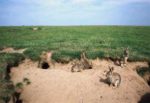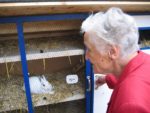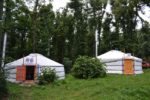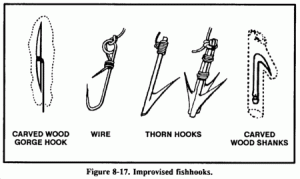Backyard Rabbit Keeping, Part 3/15 – Some Basic Information
Rabbits are not true rodents. They have two pairs of upper incisor teeth, whereas rats and mice have only one. They are very powerful teeth – a large curved pair and a smaller pair behind for support. The upper and lower teeth of the rabbit meet, and grind each other down. Possibly the worst thing that can happen to a wild rabbit since the gin trap went out is for its teeth to get knocked out of alignment because without the grinding action they grow and grow until the rabbit cannot eat and so starves to death. Tame rabbits, especially in-bred ones, are sometimes born with the teeth badly aligned. This is called malocclusion. It can be seen at about eight weeks of age. It is a genetic fault and should be traced and eradicated – that is, don’t breed from animals which hand it on to their offspring.
The full dentition of the rabbit goes as follows: 4 incisors, 6 premolars and 6 molars in the upper jaw; 2 incisors, 4 premolars and 6 molars in the lower jaw.
The rabbit has large eyes, giving good night vision; much of the wild rabbit’s grazing is done at night. Most of the daytime is spent in the burrow, where it is also dark. On average a wild rabbit spends half its life underground. Over the eye there is a third eyelid, the nictitating membrane, which flicks across if the eye is irritated or if the rabbit is nervous.

The range of vision is wide, for spotting enemies; almost all round, except directly behind and a few inches in front.
The feet are very strong, with large claws which are useful for digging – although this seems to fall to the female as wild male rabbits have not been seen to do much serious tunneling. In natural surroundings the claws wear down but when the rabbits live in hutches, they grow long and need to be clipped occasionally.
The ears are mobile and independent, like radar scanners. The blood vessels in the outer ear also help to regulate the body heat.
As the rabbit sits up to take the air, the twitching nose is perhaps the best-known thing about it. The wrinkling of the nose exposes a pad in the nostril which is particularly sensitive to all smells wafted to it. Rabbits thus take note of enemies, food and each other. They could almost be said to communicate by scent. There is a gland under the chin which produces droplets of scent onto it to mark their territory. The other day I watched a show rabbit, just taken out of its hutch, proceed to lay its scent on a table.
Respiration in the adult rabbit is normally about 45 per minute when resting, but much faster in the young and in rabbits under stress.
Whether the rabbit has a definite mating cycle or whether they mate at any time has been a subject for argument. The old books will tell you that they can be mated at any time if not already pregnant. It seems that there is a pattern of behavior, but the cycle occurs so frequently that for practical purposes you can always try a doe with the buck and if you are not successful in getting her mated, the next day could give you better luck. Naturalists report a seven-day cycle – i.e. does are ‘in season’ at seven-day intervals – but in fact the correct hormone releasing the follicle from the ovary is only produced as a result of stimulation, usually the presence of the buck.
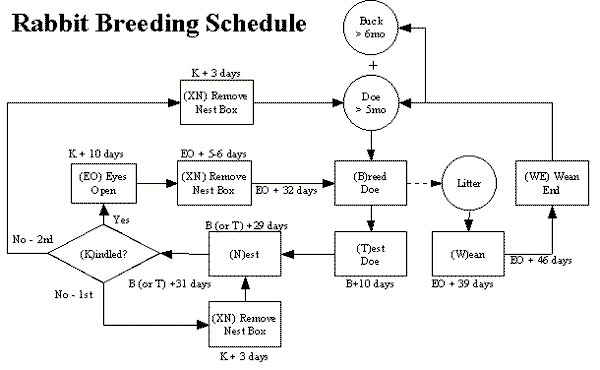 |
It has also been established that the wild rabbit has a ‘close season’ when no breeding and therefore no fighting takes place. This is in late autumn and winter and is marked by the virtual disappearance of the testicles in the male. This may be brought about by the shorter length of daylight hours and the lessening of the food supply at the end of summer. Caged rabbits, particularly in sheds, have more uniform conditions all the year round and so they can usually be induced to breed in winter as well; but from October onwards conception rates tend to be lower. Commercial rabbitries lengthen daylight at this time and keep the temperature constant at 15.6 deg C. They also feed the rabbits well. With backyard rabbits, winter production can be a problem, but with fewer litters a year your does will live longer, so why not let them have a rest if they feel like it? When we work with nature, we can afford to do this; there will be no expenses for heating and lighting to keep the temperature constant!
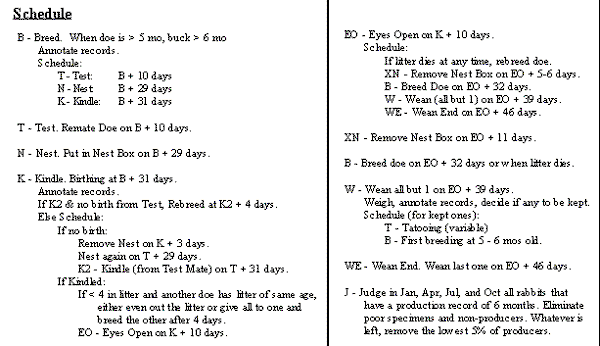 |
A month after mating, the doe makes a nest with soft hay and she plucks fur from her underside to line the nest. This helps to expose her teats, which are normally lost in the fur. Tame does make a nest in the hutch and they like a quiet dark place – hence the nest box. The babies need a warm nest because they are born so helpless. They are blind, deaf and have no fur at birth. At about ten days they begin to see and hear, and to crawl about the nest. The young are usually fed only once a day, which is surprising. They are born without teeth; at about a week the baby teeth are showing, which are replaced at a month by permanent teeth.
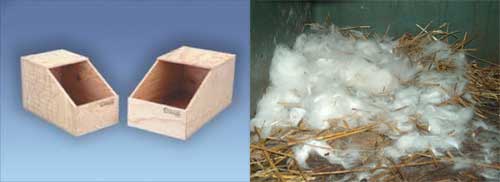
It is very exciting when the young ones first start to emerge at about 2 to 2 1/2 weeks. First you see one little nose at the entrance of the nest box or burrow, and then another. Then, with many false starts, they all coming hopping out into the light. They try a nibble or two of solid food and in a few days they are eating.
It is of great importance to feed the nursing doe well so that she has enough milk for the babies. Rabbit’s milk is very high in protein, 12-14% compared with cow’s milk at about 4%. To produce this she must have adequate food. The total solids of rabbit milk (the rest is water) have about twice the value of cow’s milk, nearly 25%. This rich food takes some producing.
Sometimes a doe, particularly a young one, has a false pregnancy. She is convinced that a litter is on the way. At about eighteen days after the onset of this, she makes a nest. The only thing to do is to wait until she gets over it and then get her mated as soon as possible. The false pregnancy is less likely to happen if the doe is re-mated while still suckling her previous litter, or just as they are weaned. If she is left without mating for some time, or run with a lot of other females, a false pregnancy may occur. To tell the real from the false when it is possible that she may have in fact conceived, you can gently feel the litter in the abdomen from the outside.
The rabbit has a stomach equipped to deal with large amounts of green food which take a great deal of digesting. It eats frequently when it gets the chance, the new material helping to push things along the digestive tract. Like other grazing animals it chews the cud or has a second go at previously ingested materials in the intervals between eating; for example, when resting in the burrow. This is mentioned in the Bible, but since then it seems to have been forgotten and only rediscovered recently. The subject is perhaps not one for polite conversation, which may be why it was overlooked for so long. Unlike the cow and the sheep, which regurgitate the material into the mouth from the rumen and chew it at leisure, the rabbit produces a special soft pellet, covered in a protein membrane. This is collected from the anus before it and is quickly swallowed. It is very difficult to observe, and you can keep rabbits for years without knowing anything about it. The fecal pellets are hard and different from the soft pellets, which are formed about six hours after the last meal and swallowed about an hour later. About one third of the stomach is filled with them; they soften and dissolve. In the wild rabbit, this arrangement allows the animal to remain underground for long periods without going out for food. It also helps to keep the burrow clean. Rabbits hardly ever, it seems, pass hard pellets underground.
This pseudo rumination has been observed in rabbits as young as three weeks.. It is thought that with fermentation in the gut, the soft pellets provide the rabbit with vitamins of the B complex. In experiments, rabbits with no vitamin B in the diet have been found to be healthy and also to be excreting excess vitamin B, so they must be able to manufacture it.
If rabbits are fed very well and are eating all the time they may stop making pellets, but under normal conditions this does not happen. Rabbits in cages with regular mealtimes may produce fewer pellets than the wild rabbit, but they do use this form of digestion, mostly at night. Even in modern hutches with wire floors and trays underneath them to catch the droppings, soft pellets are still eaten. Another name for this is corona – but this is out of favor with some rabbit keepers because it implies that the animals eat dung, and this is not really the case.
The coat of the rabbit deserves a mention. There are now three kinds of fur produced by the different breeds of rabbit, as well as the wool grown by the Angora. The normal fur of the rabbit is like that of the wild ones, with long guard hairs and an undercoat of short dense hair. In the Rex variety the guard hairs are absent, and the fur is short and velvety. The satin is another kind, with each hair having a sheen.
At ten weeks of age the little rabbit has its first molt and sheds the baby coat. At maturity it molts again and acquires then what is the prime coat – the one which furriers require. Every summer after this the rabbit will moult.
Rabbits are not usually thought of as living in families, but in the wild (as in colonies) a couple of rabbits will mate for several years, sometimes for life. The female digs a new burrow for each litter and the male moves in with her. The young are allowed to remain with them for some time longer when the breeding season ends; sometimes the father will go out with the children.
There is a ‘pecking order’ among a group of rabbits, as with other animals, and a powerful buck will possibly have several does. A younger or more timid male may have only one doe or be unable to find a mate. There is a lot of fighting at the beginning of the breeding season to establish who is the boss. When alarmed, rabbits stamp their back feet and make a thumping sound; this noise will carry through the earth a long way and act as a warning to other rabbits. If you approach a hutch suddenly, tame rabbits will do the same thing.
Disease in wild rabbits tends to come in cycles with the fluctuations in population. When the number of rabbits in an area has reached a high level, food is scarcer and the rabbits are not so vigorous. They are thinner, more prone to disease and the does tend to re-absorb the embryos of the next litter so that fewer litters are born and the population falls again.
Myxomatosis has done a lot of harm to rabbit keeping, because as I said before it took rabbit off the menu for a long time in Britain. It was not until yesterday that I saw a newspaper article about a game dealer who said that rabbit is becoming popular as a food once more. They make a healthy family meal and the dealer said that this was the cheapest meat he sold.
When the disease broke out first in 1953-54, the country was suffering from rabbit overpopulation and the animals were a pest to farmers and foresters. It was therefore policy to encourage the spread of the disease and many people did so. It is a horrible affliction; many are familiar with the sad sight of a swollen-faced rabbit wandering helplessly about. Some authorities state that the rabbit dies in agony, others suggest that the disease itself lessens sensitivity to pain. I hope this is true. Affected rabbits will still eat, and even attempt to mate. The disease only attacks the European rabbit, but of course Australian rabbits were European in origin. It is carried by biting insects such as fleas and mosquitoes, although British mosquitoes do not seem to be very effective carriers. In wild rabbits the carrier is usually the flea, Spilopsyllus quniculi, which migrates from dead rabbits onto living ones. This is the only way that a dead rabbit can infect a healthy one.
The fear of the disease is one reason why commercial rabbit keepers like to keep their flock in a shed, with gauze on the windows. I do not think though that it is a good enough reason for depriving your backyard stock of fresh air and sunshine, because there is something you can do. If the disease flares up again in wild rabbits in your area, you can vaccinate your breeding stock against very cheaply from most reputable farm veterinarians.
Since the rabbit population was seriously reduced in the 1950’s by this disease, it now seems to be occurring in sporadic outbreaks. Some of these are man-induced regrettably.
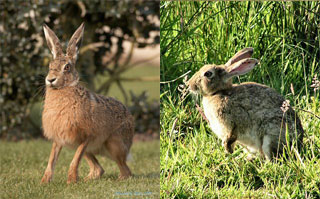 Perhaps we should close this chapter on rabbits in general by considering the hare, which is a relative. Hares are native to Britain; they have always been with us, and always wild and solitary. Their erratic behavior in the Spring has caused them to be regarded by country people with deep suspicion.
Perhaps we should close this chapter on rabbits in general by considering the hare, which is a relative. Hares are native to Britain; they have always been with us, and always wild and solitary. Their erratic behavior in the Spring has caused them to be regarded by country people with deep suspicion.
Rabbits belong to children’s stories, but hares are part of the folklore; they were witches in disguise, running from mortals. The hare is bigger and rangier than the rabbit, with black-tipped ears which are longer than rabbits’ ears. The two do not breed; the so-called ‘Belgian Hare‘ is a true rabbit, though a big one.
- Why Why Keep Rabbits?
- Rabbits Past and Present
- Some Basic Information
- Making a Start
- Housing
- Feeding
- Growing Crops for Rabbits
- Breeding
- Health
- Harvesting the Wild Rabbits
- The Harvest
- Using Rabbit Meat
- Fur Production
- Showing
- Angoras
Further Research:
   |
